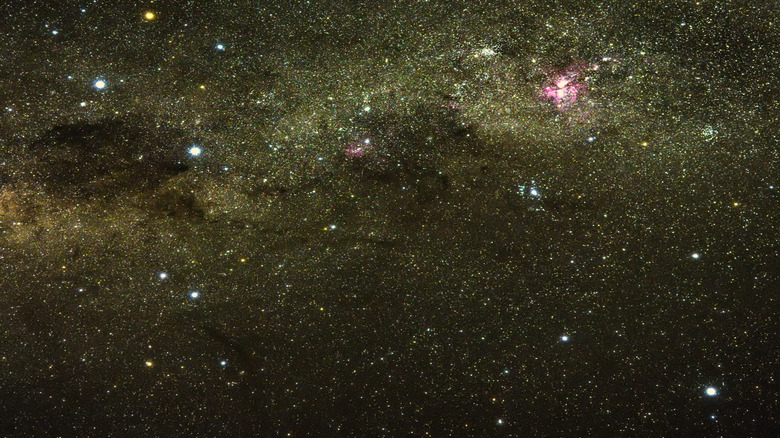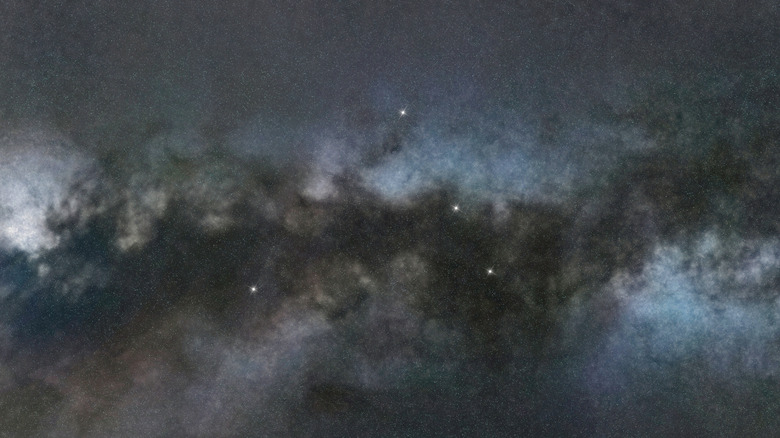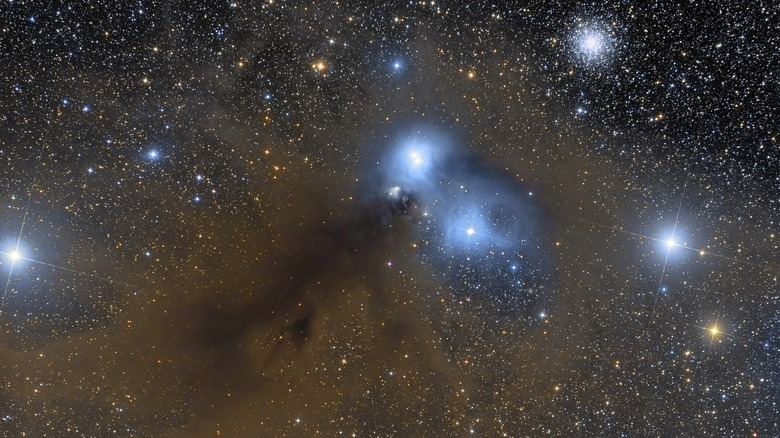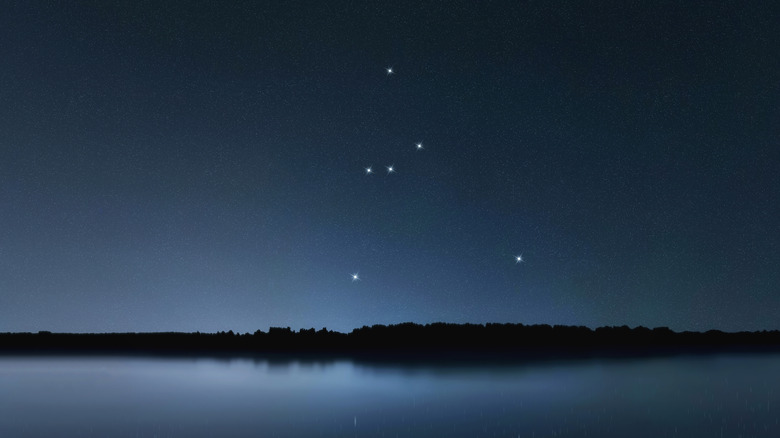Constellations You'll Never Get To See In The Northern Hemisphere
Humanity has spent literal millenia looking toward the night skies, tracking the stars that blazed against the darkness and finding images — constellations — out of the patterns they saw there. If you live in the northern hemisphere, there are a few staple constellations that you're probably rather familiar with: Ursa Major, Ursa Minor, and Orion, among plenty of others. But for all the stars seem like something shared by everyone — after all, a clear night and a view of the sky is all you need to see the stars — the truth is a bit more complicated.
In fact, not all constellations can be seen by everyone in the world, and the constellations themselves shift depending on the season, a result of Earth's rotation around the sun. However, at latitudes close enough to the poles, there are certain constellations that can be seen nearly in their entirety year round. These circumpolar constellations are largely unique to each hemisphere (though not completely unique, as those near the equator can likely catch glimpses of both northern and southern circumpolar constellations). Formations like Perseus, Cassiopeia, and Ursa Major are visible in the skies of the northern hemisphere year round, while ones like Orion are situated around the equator, meaning that they can easily be seen in both hemispheres, depending on the time of year.
And, of course, that means the southern hemisphere also has its own constellations that many people living in the northern hemisphere probably can't see in full, and may not even be particularly familiar with.
Carina
Though the common myth about the North Star being the brightest star in the sky isn't something you should believe, were you to look for a bright spot in the skies of the southern hemisphere, you'd probably find the star Canopus, or Alpha Carinae. This star is second only to Sirius in terms of brightness in the southern hemisphere, and it's one of the many remarkable features of the constellation Carina.
Forming something like a spiral, Carina is actually home to quite a few notable astronomical objects aside from Canopus. For one, there's the Carina Nebula — technically a group of smaller nebulae and star clusters — which is not only far brighter than the northern hemisphere's Orion Nebula, but also about four times as large, despite being six times further away from Earth. Then, you've also got a number of prominent star clusters, one of which — IC 2602 — is one of the brightest clusters in the sky, giving it the nickname the "Southern Pleiades."
As for where Carina got its name? Well, the constellation is also known as "the Keel," a reference back to its origins, as it was once part of a much larger constellation called Argo Navis. And if you're familiar with Greek mythology, you might think of Jason and the Argonauts — a group of heroes who sailed on a ship called the Argo to claim the Golden Fleece. After a successful journey, the ship was moved into the sky and turned into a constellation; Carina is the ship's keel (the main structural component of the hull) and eventually became known as its own constellation, rather than just a part of Argo Navis.
Centaurus
If you read the name of the constellation Centaurus and thought the name reminded you of the centaurs from Greek mythology, then you should be pleased to know that you're right on track when it comes to its origin. As one of the largest constellations in the sky, Centaurus was noted by a number of ancient civilizations; the Babylonians associated it with a creature that was a cross between a man and a bison, and both the Greeks and Romans saw the centaur, a mythical being with the head and torso of a man, but the legs of a horse. The specifics of the mythos get a little fuzzy, though. Prominent Greco-Roman writers claimed that Centaurus represented a specific centaur — Chiron, the wise mentor of many Greek heroes, from Achilles to Heracles to Asclepius. That seems like a reasonable choice, but the trouble comes from other ancient writers, who associated Chiron with another famous constellation, Sagittarius.
Regardless of the name's origins, Centaurus is also notable for a few other reasons. It contains quite a few notable astronomical objects, including Alpha and Beta Centauri (two of the brightest stars in the sky), Centaurus A (a spectacularly bright galaxy), and an impressive handful of different nebulae. Not only that, but it's worth noting that Centaurus can kind of be seen from the northern hemisphere. It's circumpolar for most of the southern hemisphere, but if you're within about 25 degrees north of the Equator, you can catch a glimpse of the most northern bits of the constellation, which just happen to contain Alpha and Beta Centauri.
Crux
When it comes to prominent constellations in the southern skies, there are quite a few of them that are known for being pretty large — even ranking among some of the most massive in the entire night sky. But on the opposite side of the spectrum is the Crux constellation; in fact, it's the smallest constellation of the 88 currently recognized by the International Astronomical Union. This tiny constellation is a tight grouping of four or five stars — the exact number depends on who you ask — situated only about 5 degrees apart from each other, though the four brightest of them form the points of a cross when looked at as their own, smaller group; fittingly, this asterism (an unofficial grouping of stars within a constellation) is widely known as the Southern Cross constellation, which, fortunately, is pretty easy to find.
Historically, Crux played a role similar to that of the North Star when it came to ways that ancient people used stars and planets — seafaring and navigation, in particular. Much like northern travellers could point themselves toward the North Pole by following Polaris, Crux could direct travellers to the South Pole. The northern and southernmost stars (Gacrux and Acrux, respectively) fall along a straight line that points right at the pole.
But even if navigation isn't your thing, then Crux still has some other factors going for it. The constellation is also home to the Coalsack Nebula, which appears as a strangely dark patch of sky against the Milky Way, as well as the Jewel Box Cluster, a famously beautiful group of blue and orange stars named for the way they twinkle like jewelry.
Triangulum Australe
A bunch of famous constellations have names that come from Greek mythology, accompanied by stories coming from ancient times — Andromeda, Cassiopeia, Perseus, and plenty of others. But that's not the case for every constellation.
Take Triangulum Australe, for example. When you translate the Latin terms, the name in English literally just means "Southern Triangle," a direct reference to the way that the three stars create the points of an equilateral triangle. On top of that, the constellation is nowhere near as old as those with Greek origins, with the first mentions of it coming about in journals written by Dutch navigators and astronomers in the late 16th century. But its name wasn't so easily settled on. Its current name was decided on in 1603, but prior to that, it was referred to instead as Triangulus Antarcticus. Then, in the mid 1700s, it became a part of a trio of constellations, each one named after a different surveying tool; Triangulum Australe was known as the level, which earned it two different names from two different astronomers ("le Triangle Austral ou le Niveau" in 1756 and "Libella" in 1801).
It's a pretty small constellation, though not without its fair share of stunning galaxies — a couple of which are in the process of swirling into each other — as well quite a number of colorful nebulae. That said, very little of that is visible from the northern hemisphere; European countries can't even catch a glimpse.
Corona Australis
Those living in the northern hemisphere are probably familiar with the constellation Corona Borealis. Even if not for the constellation itself, there's a good chance you've heard of something similar due to the rare T Coronae Borealis Nova event that's slated to take place sometime in 2025 (though that's not exactly a guarantee, given astronomers have been predicting this event since 2024). In Latin, the name translates to "the northern crown," so it only makes sense that it has a counterpart in the southern hemisphere — a "southern crown," or Corona Australis.
The constellation is mostly visible in the southern hemisphere, but below latitudes of 40 degrees north, you can also catch a glimpse of it. (Granted, going even a bit further north means that the constellation will be impossible to see.) In fact, the ancient Greeks even made note of it, though the exact interpretation of its shape varied by astronomer, with some of them seeing a crown, others a quiver of arrows, and yet more seeing a wreath placed in the sky by the god Dionysus. If nothing else, though, it's thought to have some connection to the myth of Hercules.
Generally speaking, the stars are pretty dim, making it a hard constellation to see, and overall, it's difficult to make out many features through a thick layer of dust (which does, however, have a tendency to reflect light in brilliant patterns). That said, astronomers do typically look towards the area for a number of different star systems, as well as the yearly Corona Australids, which shoot through the sky every March.
Hydrus
Though ancient Greek astronomers were often able to glimpse constellations that are primarily located in the skies of the southern hemisphere, they couldn't always see everything stationed over that part of the globe. One such constellation was Hydrus. And, no, it's not the same as the constellation Hydra; the two just have very similar names. Both come from the same root and translate roughly to "water snake," though their differing suffixes tell the rest of the story. Hydra specifically refers to "the female water snake," while Hydrus translates to either "the male water snake" or "the lesser water snake." In short, the latter is just a bit smaller, and the two are separated by a couple other constellations.
However, while Hydra was named after a creature from Greek myth, Hydrus was named far later, when Dutch explorers passed through the area around the turn of the 17th century, choosing the name as a reference to the sea snakes that they saw along the way.
And as for some cool astronomical objects contained within Hydrus? Of particular note is the star HD 10180. Of a comparable size to the sun, this star also plays host to a bunch of exoplanets; at the moment, scientists are aware of somewhere between seven and nine planets in orbit around the star, which would make it the largest system of exoplanets currently known.






